Guangzhou Restaurant
 |
|
Door Screen
|
The Guangzhou Restaurant, located at the corner of Wenchang Nan Road and the famous Shangxiajiu Street in the Li Wan district, has a long and distinguished history dating back to 1935. The restaurant can cater for as many as 10,000 people a day and has branches as far apart as Hong Kong and Los Angeles. Comprised of three floors, the first offers a selection of Chinese and Western food. The ethos of the restaurant however is to provide traditional Cantonese food and you can find plenty to choose from on the second and third floors.
 |
|
Ming-style arm-chair and window-etching
|
The layout and décor is typical of a traditional Cantonese restaurant with courtyards and rooms of various sizes on arcaded corridors. However, the restaurant has a few distinctive features of its own, most notably a Rong Shu (tree), growing in the middle of the restaurant and a selection of hand crafted stained glass windows dating from the Ching Dynasty (1644-1911). If you would like to sample some traditional Cantonese food, history and culture all at the same time, then the 'Guangzhou Restaurant' is well worth a visit.
For starters you could try the 'Dong Gua Chen Oi Ya Tang', which is a crisp, full-flavored soup made with duck and Chinese watermelon. Alternatively, sample the 'Lu Shui Hua Sheng'. These are peanuts, at least twice the size of your average peanuts, soaked in water and slowly simmered with a selection of herbs and spices. The nuts originate from North East China and have a mild taste and almost creamy texture.
 |
|
Lu Shui Hua Sheng (Peanunts)
|
Some dishes typical of the restaurant include 'Si Bao Chao Niu Nai', which translates as fried milk. This dish is 80% milk and 20% egg white, which is mixed together, fried, and served with ham, shrimp and olive kernels. The texture is similar to scrambled eggs but much smoother and the white color of the dish makes it distinctive. It has a slightly salty taste, which combines well with the sweet taste of the olive kernels.
 |
|
Fried Milk
|
 |
|
Steamed Guiyu fish
|
'Gui Yu Xin Zhuang' is a steamed fish, which is served whole, boned and tailored into bite size pieces in a light soy sauce. Strips of fish meat are placed around a slice of pickled vegetable and bound with aromatic caraway leaves - a biennial Eurasian herb (Carum carvi) belonging to the parsley family. The taste of the fish is delicate, providing an interesting contrast to the sharp taste of the pickled vegetable and fragrant caraway leaves.
 |
|
Amaranth Egg Soup
|
 |
|
Osmanthus Sausage
|
'Hong Shao Rou Chao Feng Yan Guo', is primarily comprised of small, roasted, yellow colored nuts produced by the Peng Po tree, about half the size of a chestnut and similar in taste and texture. These nuts are roasted and served with pork and vegetables. This dish is healthy and rare as the nuts are only available during the months of July and August.
Other dishes include: 'Wen Chang Chicken', 'Kapok Duck', 'Deep Fried Duck Palm', and 'Three-colored Lobster'. The restaurant also offers a wide selection of deserts including 'milk tarts' and an edible Chinese chess set made with sugar, egg white, coconut and coco powder. The moon cakes of Guangzhou Restaurant are famous.
Finally, if you have something special to celebrate and feel like 'splashing out' you could try the 'Man Han Da Quan Yan' which can be translated as 'Emperors Banquet'. This is a vast selection of dishes served by staff wearing traditional clothes worn by the servants of Emperors during the Ching Dynasty. Step back in time and enjoy the tastes of old Guangzhou.
Prices are reasonable and you can find enough to eat whatever your budget.
Address: 2, Wenchang Nan St., Liwan, Guangzhou
Tel: 8138 0985, 8138 0762, 8139 5253
Songfeng Xuan
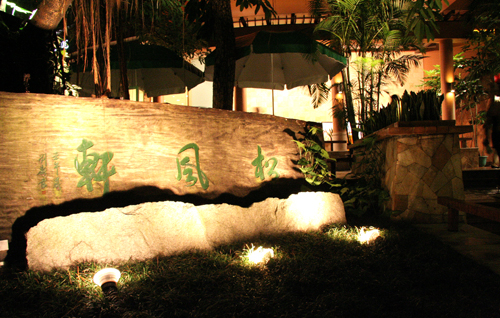
It's a rare treat to find an excellent restaurant embedded in a mountainous park. But Guangzhou is blessed with one; the Songfeng Xuan (Tower in Pine Breeze) Restaurant, at Mingzhulou in Baiyun Park. Two of us from GZ Daily were there as the guests of Managing Director Mr. James Chen, hot on the heels of the Gotherberg crew, who'd been there only a couple of days before and who after months on the ocean were probably grateful for something other than seafood!. To our pleasure, we were served the same exotic banquet the intrepid sailors had enjoyed.
Properly prepared Cantonese fare is extremely healthy, with an emphasis on freshness that's not commonly found in many Western restaurants. Vegetables in particular, are served underdone to preserve their colour, texture and taste.
And what a banquet they serve. Barbecued eel, that old Cantonese mainstay boiled chicken – without the fatty white skin, a boiled spinach dish (yes spinach! not gok choy), a fish as tasty as was delightfully boneless, jiaozi served upside down and fixed to a thin layer of pastry.
The room was unpretentious, decorated in pale yellows with the usual tile floor. A large circular table in the middle and plenty of space around it. The restaurant can accommodate up to 1,000 people, in very tasteful surroundings. You wouldn’t know that from looking at it, but there are many private rooms, each with unpronounceable 8 syllable Latin botanical species names, some of which (eg. Clitoria Ternatea) really catch the eye. It must be fun trying to reserve them over the phone!
Access to the restaurant is the only real hassle. If you live nearby, you can walk there or ride a bicycle if you like a challenge. If you have a car, you can drive it in and there are plenty of places to park. But therein lies the problem. You're also entering a quasi-national park, and it costs 5 yuan per person and 15 yuan per car. No major problem if you're driving your own vehicle – if you can afford the price of petrol you can certainly afford to get into Baiyun Park. The pointy end of the stick is that if you're relying on taxis, you can get one to take you in, but you can't get one to take you home again. Drivers are unwilling to pay 15 yuan to enter the park and take the risk they might not be able to locate their passenger at the top of the hill. And you can't blame them. So it's a brisk 20 minute walk down the hill, which is okay on the balmy summer nights but might be less fun in a sudden rainstorm.
Locomotive Restaurant with Romantic Ambience
Add: 1, Shamian North St., Guangzhou
Tel: 8121 8882; 8121 5226
Business Hours: Sat-Sun 11.30am-1am, Mon-Fri 5.30pm-1am.
All cards.

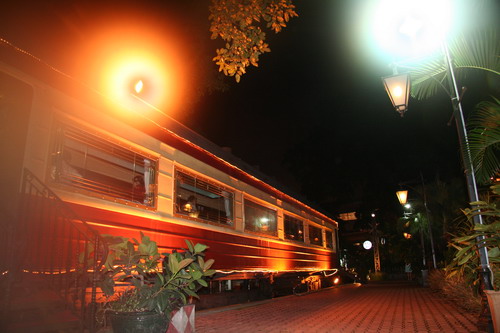
Nestled among trees at the eastern end of Shamian Island is the Locomotive restaurant, comprising a main "station" building nestled between two railway carriages. The carriage on the left has been done out with two private banqueting rooms, the one on the right – originally a dining car – is done out in mock-1930's style, with period tables, chairs, carpets, light-fittings, original wooden floors and window frames.
The menu is international, with dishes from a variety of countries, and very well done. An Italian-trained chef served up Mushroom Soup and Farmer Pumpkin soup, followed by Grilled Duck Breast, Grilled chicken with lemongrass and Baked Sole Fillet with Champagne Cream Sauce.
Then the desserts: Hot Chocolate Pudding, Almond Parfait , Tiramisu, Green Tea Cake and Mango Pudding
Best dessert was the Chocolate Pudding, though it had strong competition from the Tiramisu which my Italian companion went into raptures over.
The "Station" is a larger dining area featuring leather chesterfields and a curiously simple but effective lighting system, which illuminates in turn the names of famous European railway stations – Gare d'Orsay, Gare St. Lazare, Stazione S Lucia, to name a few. It will bring back memories of home for visitors from Europe.
Daye Feng Fan (Hainan Cuisine)
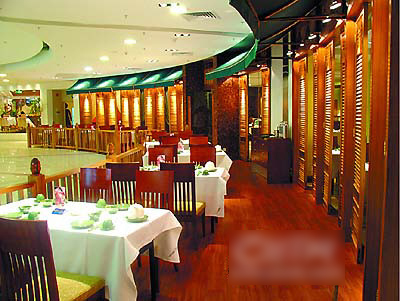
Daye Feng Fan, meaning "big coconut and rice", is Guangzhou's largest Hainan restaurant, very clean and proud of its food safety record.
Hainan cuisine is lighter than Cantonese cuisine, with mild seasonings. Signature dishes include Wenchang Chicken and Dongshan Goat.
Wenchang chickens are fleshy birds originating in Wenchang City, a small town in the north of Hainan Island. Fed on rice, their meat is succulent.
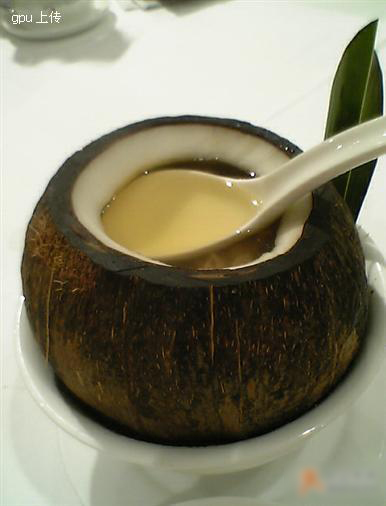 |
|
Braised Chicken in Coconut.
|
Wenchang chicken is best cooked braised in water. When the bones turn a little bloody, it’s chopped into small chunks before being served. Diners dip it in a special ginger sauce before eating.
Hainan Island yields an abundance of tropical crops like coconuts, pepper, coffee and tea. The island is also home to a variety of fruits and Chinese medical herbs. Fresh seafood is included in the home-style dishes.
Hainan chicken rice and coconut oil rice are good complementary staple dishes. No doubt, the fragrance of chicken and coconut gives you an appetite.
Other recommended dishes include Hainan kidney bean, osmanthus-flavored wine and Dongshan Goat.
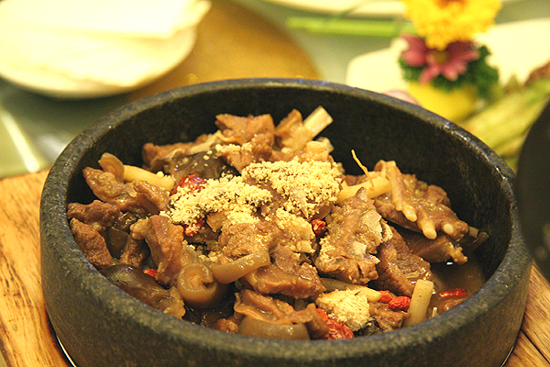 |
|
Dongshan Goat.
|
Add: 6/F, Grandview Plaza 228, Tianhe Rd. Tianhe, Guangzhou
Tel: 020-3833 0831